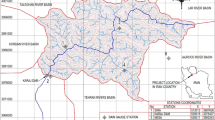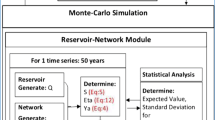Abstract
In a multi-reservoir system, the stochastic nature of basin data resulting from rainfall introduces risk into water management operations. Effective management that accounts for these risks can obtain maximum benefits from the system. This study presents a description of a multi-reservoir water resources system with hydroelectric power plants, utilizing the energy optimization model developed by OPAN in 2007. The model was applied to reservoirs located successively on the Lower Kızılırmak River in the Kızılırmak Basin, with the objective function being the maximization of firm power by using drought period inflows and total energy by using monthly average inflows. The study considered three scenarios: deterministic, probabilistic, and risky (critical cases), with probabilities of inflows from the basin being determined for the latter. Monthly inflows with determined probabilities were used to obtain data for the risky case. Optimum operating levels were determined based on this data to maximize firm power and total energy. According to the operating levels, the reservoir with the largest useful volume manages the operation. The values obtained from the optimization were then used in multivariate regression analysis using the Statistical Package for Social Scientists (SPSS), a statistical analysis program. The analysis explored the effects of monthly operating levels in the reservoirs, the amount of inflow released from the spillway, the amount of inflow released for energy production, the monthly average inflow to the reservoirs, and firm power values on energy production.







Similar content being viewed by others
Availability of Data and Materials
Available from the corresponding author on request.
References
Ahmadianfar I, Bozorg-Haddad O, Chu X (2019) Optimizing Multiple Linear Rules for Multi-Reservoir Hydropower Systems Using an Optimization Method with an Adaptation Strategy. Water Resour Manage 33:4265–4286. https://doi.org/10.1007/s11269-019-02364-y
Alemdar F (2019) Energy Optimization of Successive Dams in the Lower Kızılırmak Basin, Master Thesis, Sakarya University, Institute of Science, Sakarya, 20–21
Asvini MS, Amudha T (2022) Maximization of Energy Production from Sholayar Hydropower Plant in India. In: Khosla, A., Aggarwal, M. (eds) Renewable Energy Optimization, Planning and Control. Studies in Infrastructure and Control. Springer, Singapore. https://doi.org/10.1007/978-981-16-4663-8_12
Balcanlı ÜG, Dikbaş F, Baran T (2012) Entropy Method in Drought Analysis. VII. National Hydrology Congress, Süleyman Demirel University, Isparta, 26–27 Eylül 2012
Beça P, Rodrigues AC, Nunes JP et al (2023) Optimizing Reservoir Water Management in a Changing Climate. Water Resour Manage 37:3423–3437. https://doi.org/10.1007/s11269-023-03508-x
Bernard T, Idoud N, Khalah L, Ye´lou, C., (2007) Finite Sample Multivariate Structural Change Tests With Application To Energy Demand Models. J of Econometrics 141:1219–1244
Çakmak B (2002) Evaluation of Irrigation System Performance in Kızılırmak Basin Irrigation Unions. KSÜ Journal of Science and Engineering 5(2):130–141
Danladi N, Yunusa MB (2019) Effect of Weather Variables on Reservoir Inflow for Hydroelectric Power Generation in Jebba Dam, Nigeria. 2rd School of Physical Sciences Biennial International Conference, Nigeria, 24–28 June 2019
De Ladurantaye D, Gendreau M, Potvin JY (2009) Optimizing Profits from Hydroelectricity Production. Comput Oper Res 36:499–529
Durmuş B, Yurtkoru ES, Çinko M (2011) Data Analysis with SPSS in Social Sciences, 4th Edition, Beta Publishing, 143
Fayaed SS, Fiyadh SS, Khai WJ, Ahmad AN, Afan HA, Ibrahim KR, Fai CM, Koting S, Mohd NS, Jaafar WZ, Hin LS (2019) Improving Dam and Reservoir Operation Rules Using Stochastic Dynamic Programming and Artificial Neural Network Integration Model. Journal of Sustainability 11:5367. https://doi.org/10.3390/su11195367
General Directorate of State Hydraulic Works (DSI) (2014) International Commission on Great Dams Turkish National Committee, Dams in Turkey, 1st edition, DSI Foundation, Ankara
Gonzalez JM, Olivares MA, Medellín-Azuara J (2020) Multipurpose Reservoir Operation: a Multi-Scale Tradeoff Analysis between Hydropower Generation and Irrigated Agriculture. Water Resources Manage 34:2837–2849. https://doi.org/10.1007/s11269-020-02586-5
Hatamkhani A, Moridi A (2019) Multi-Objective Optimization of Hydropower and Agricultural Development at River Basin Scale. Water Resour Manage 33:4431–4450. https://doi.org/10.1007/s11269-019-02365-x
Jaafar HH (2014) Maximizing Hydropower Production From Reservoirs: The Case Study Of Markaba. Lebanese Sci J 15(2)
Labadie JW (2004) Optimal Operation of Multi-Reservoir Systems: State-Of-The-Art Review. J Water Resour Planning and Manage 130(2):93–111
Malley ZJU (2011) Climate Change and Water Resources for Energy Generation in Tanzania. World Renewable Energy Congress, Sweden, 8–13 May 2011
Opan M (2007a) Multiobjective Optimal Operation in Multiple Reservoir Systems, PhD Thesis, Kocaeli University, Institute of Science, Kocaeli, 232690
Opan M (2007b) Energy Optimization with Successive Approximation Dynamic Programming in Long-Term Planning in Multi-Reservoir Systems, Ministry of Culture and Tourism of the Republic of Turkey, Registration no: 2022/7840, Registration date: 27.12.2022, Production date: 13.09.2007
Özdamar K (2011) Statistical Data Analysis with Package Programs. Kaan Bookstore, Istanbul
Özkan G (2016) Economic Effects of Regulatory Reforms on the Turkish Energy Market, Master Thesis, Kırıkkale University, Kırıkkale
Rahardjo IA, Subekti M, Gunawan W, Wijayanto RP, Mahir I (2021) The Effects of Rain Intensity and Water Elevation with Energy Productivity of Kracak Hydro Power Plant, Bogor Regency – West Java. J Phys Conf Ser 2111. https://doi.org/10.1088/1742-6596/2111/1/012044
Rahimi H, Ardakani MK, Ahmadian M (2020) Multi-Reservoir Utilization Planning to Optimize Hydropower Energy and Flood Control Simultaneously. Environmental Process 7:41–52. https://doi.org/10.1007/s40710-019-00404-8
Rani D, Moreira MM (2010) Simulation-Optimization Modeling: A Survey and Potential Application in Reservoir. Water Resour Manage 24:11071138. https://doi.org/10.1007/s11269-009-9488-0
Shim K-C, Fontane D, Labadie J (2002) Spatial decision support system for integrated river basin flood control. J Water Resour Planning and Manage 128(3):190–201
Tai F (1984) Optimization of Operating Procedures for Multi-Reservoir System Under Stochastic Inflows, Master Thesis, Manitoba University, Kanada
Tayfur G (2017) Modern Optimization Methods in Water Resources Planning, Engineering and Management. Water Resources Manage 31:3205–3233. https://doi.org/10.1007/s11269-017-1694-6
Tranmer M, Murphy J, Elliot M, ve Pampaka M (2020) Multiple linear regression (2nd Edition). Cathie Marsh Institute Working Paper. Access Adress: https://hummedia.manchester.ac.uk/institutes/cmist/archivepublications/workingpapers/2020/2020-1-multiple-linear-regression.pdf
Yi J, Labadie J, Stitt S (2003) Dynamic optimal unit commitment and loading in hydropower systems. J Water Resour Planning and Manage 129(5):388–398
Zhang X, Peng Y, Xu W (2019) An Optimal Operation Model for Hydropower Stations Considering Inflow Forecasts with Different Lead-Times. Water Resources Manage 33:173–188. https://doi.org/10.1007/s11269-018-2095-1
Acknowledgements
In this study, gratitude is expressed to Professor Doctor Mücahit OPAN for granting permission to use the energy optimization program developed by him in 2007 for long-term planning of the multi-reservoir system.
Funding
No funds, grants, or other support were received during the preparation of this manuscript.
Author information
Authors and Affiliations
Contributions
Material preparation, data collection and analysis, manuscript preparation, review and editing: E. Bacaksız; dynamic programming model analysis, review: M. Opan; review and editing: Z.E. Kara, M. Karadeniz.
Corresponding author
Ethics declarations
Ethical Approval
The authors declare that the manuscript has not been published to other journals.
Consent to Participate
All authors gave consent to participate in this study.
Consent to Publish
All authors gave consent to publish this manuscript.
Competing Interests
The authors have no relevant financial or non-financial interests to disclose.
Additional information
Publisher's Note
Springer Nature remains neutral with regard to jurisdictional claims in published maps and institutional affiliations.
Rights and permissions
Springer Nature or its licensor (e.g. a society or other partner) holds exclusive rights to this article under a publishing agreement with the author(s) or other rightsholder(s); author self-archiving of the accepted manuscript version of this article is solely governed by the terms of such publishing agreement and applicable law.
About this article
Cite this article
Bacaksız, E., Opan, M., Kara Dilek, Z.E. et al. Evaluation of Optimal Energy Productıon Usıng Deterministic, Probabilistic and Risky Cases In a Multi-Reservoir System. Water Resour Manage 37, 5829–5848 (2023). https://doi.org/10.1007/s11269-023-03633-7
Received:
Accepted:
Published:
Issue Date:
DOI: https://doi.org/10.1007/s11269-023-03633-7




